|
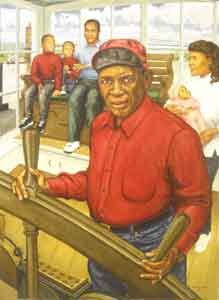
Henry
Williams, River Man
Oil on canvas,
30" x 40", Completed December 28th, 1998
Oil painting by Tom Lohre and
given by him to the Cincinnati Area Senior Services to hang in the Over-the-Rhine
Senior Center, Cincinnati, Ohio. Henry Williams is in the foreground of
the pilot house of the stern wheel tow boat, W. P. Snyder, located at
the Ohio River Museum in Marietta, Ohio. The Orson Austin family is in
the background of the pilot house for Tom has not yet found Henry's family.
From left to right Jude, Theo, Orson, Sophie and Sophie Austin.
The Story
Henry Williams has returned home.
The Ohio river man that spent the latter part of his life living in the
Over-the-Rhine area of Cincinnati now has his portrait hanging in the
Over-the-Rhine Senior Center. His parents were former slaves and farmed
alongside the Mississippi River. Henry decided to spend his life on the
Ohio River. As a young man he started working for Captain John Beatty,
legendary river man. Henry worked as a crane operator, pilot, diver, welder
and engineer raising salvage off the bottom of the inland waterways.
His brother William, was also a river man. William was a victim on the
steamboat Island Queen's explosion in Pittsburgh on September 9th, 1947.
Henry went with Captain Beatty to salvage the Island Queen. He recalled
scrambling for dimes that fell out of the slot machines while raising
the steamboat. Henry worked as the dock master for the floating converted
stern wheel restaurant Mike Fink's, built by Captain Beatty. Everybody
had a nickname on the river, Henry's was "Greenboy."
Henry was Tom's first boss. In high school Tom and his identical twin
brother Chuck started working for Henry as dock boys for the Mike Fink
Restaurant & Marina. Tom went on to become a portrait painter
and after living in New York City for twenty he returned home to Cincinnati.
There he began applying for various art programs the city and state administer
to learn how to produce contemporary art.
In 1998 he proposed to the City of Cincinnati a portrait of Henry Williams
to hang in the Over-the- Rhine Senior Center and the City gave him moneys
to pay for materials. Tom gave several informal talks to the patrons of
the Over-the-Rhine senior center as he completed the portrait. At each
talk Tom brought the unfinished painting and painting materials. He would
go from table to table engaging patrons waiting for lunch and speak of
the portraits process. Ms. Virginia Fox, director of Cincinnati area senior
centers, was extremely helpful in getting the project off the ground.
Ms. Dory Bonds, the Over-the-Rhine senior center director, was very instrumental
in making the portrait making talks a exciting and wonderful event.
One of the elders remembered Henry and used to work with him around 1948.
Tom is still looking for Henry Williams family. When the painting was
dedicated a young woman came forth and said that Henry lived alone in
a room behind the Gold Star Chili on Race Street across from Findlay Market.
Where the Painting Is
The portrait hangs at the Over-the-Rhine Senior Center; 1720 Race St.;
Cincinnati, Ohio. Contact at the center: Dory Bonds 513-381-3007. The
center is open Monday through Friday from 8 am to 4 pm closed on major
holidays.
Description of
the Painting
The 30" x 40" oil on
canvas portrait shows Henry Williams in the foreground of the pilot house
of the W. P. Snyder, a restored stern wheel tow boat at the Ohio River
Museum in Marietta, Ohio. Both his hands are holding pins on the huge
ten foot diameter wheel and he is looking intently just past the viewer.
A family is in the background with the men seated on the left on the "liars"
bench, a long bench along the rear of the wheel house. Off to the right
is a mother holding her child. There are windows all around the pilot
house. The Mike Fink's restaurant is on the left with the Suspension bridge
spanning across the river and the entire canvas. The colors are red, white
and blue with the pilot house white. Henry's shirt is red and pants are
blue jean. The two boys wear red turtle necks, jeans and sneakers. Tom
used the Orson Austin family for Henry's family because Tom has not yet
located Henry's. Orson and his wife Sophie are avid art collectors and
were very helpful in completing the portrait of Henry. Tom had painted
their two boys in the past. This was the first portrait where Tom painted
a full size figure in the foreground and a group of smaller figures in
the back ground.
Materials funded by the City of Cincinnati. Time and expertise donated
by Tom Lohre. Tom donated the portrait to Cincinnati Area Senior Services
so the portrait would hang at the Over-the-Rhine senior center in perpetuity.
Additional Information
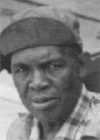
Photograph of
Henry Williams taken about 1971.
The Story of
Tom's High School Job
Tom's family had a houseboat moored
at the Captain Hook's marina and restaurant at the foot of Broadway in
Cincinnati, owned by Captain Beatty the marina started the river front
revival in Cincinnati. Tom and Chuck were sophomores at St. Xavier High
School and wanted a job. Tom took a bus to the new floating restaurant
Mike Fink's in Kentucky and asked for the owner Captain Beatty. The manager
directed him to Captain Hook's across the river. Tom walked across the
Suspension Bridge and along the bank to the bar at Captain Hook's where
he found Captain Beatty. Captain Beatty could be seen in town from time
to time when his salvage rig was moored just above Captain Hooks behind
the ice piers. Captain Beatty was a huge muscle of a man sitting at the
bar with his best bartender serving him. Captain had a white complexion,
light eyes, blond brown balding hair and a kind look about him when he
wasn't mad as hell which had been reported on more than several occasions.
Once telling him of his request Captain asked him how he got there. The
initiative Tom took to walk across the bridge convinced Captain and he
gave Tom and Chuck a job. They were to work part time on the weekends
and full time during the Summer.
Their first day of work was massive over kill. Tom & Chuck were
so anxious that they practically followed Henry into the bathroom. They
worked so hard and feverishly that everything that could possibly be done
was done long before the end of the day. The manager came around the corner
and berated Henry for not putting the twins to work doing something but
all Henry could say was that everything had been done. That was when the
twins got their nicknames of Handy and Dandy. Tom being the first twin
was Handy.
Description of
Henry
Henry was a large man old in his
ways quite in his demeanor. He usually had a pair of coveralls on made
out of gray fisher cloth. He wore a plaid flannel shirt and blue jeans.
His boots were always seemingly always new and had steel toes. He normally
had a pack of cigars handy and looked forward to a little nip at the end
of the day. He also had a large folding knife that he kept quite sharp.
He could be seen sitting on the step of the toe knee whittling at the
end of the day. His head was round and he had some scars on it but
they were not that noticeable. His color was dark negroid. He didn't have
much if any hair and always wore a railroad cap with the bill turned up.
His hand were large and knurled in a way indicative of age. His
nails were intact and always clean.
Henry's Life
Henry worked continuously with
a nice pace. At the time I met him he was more or less retired. He was
in his seventies and had worked for Captain Beatty for 40 odd years. He
spoke of his parents being slaves but little else. He mentioned raising
the Island Queen but not that his brother was killed on it. Henry was
quite about his history. I always left that he had a family but never
was introduced to them. I have a vague recollection that I met his wife
on day in the afternoon at Mike Finks'. The last time anyone saw Henry
was in the late 1970's in Mt. Adams. He may have been with his daughter.
It is believed that Henry lived into the late 1980's.
Henry for the most part lived quietly and spoke little of himself.
Henry's Work Day
After working for him for three
years I can only recall the routine we did everyday. First we took out
the trash, second we washed the decks before the lunch crowd. Then we
got our dinner and sat on the steps going upstairs from the main front
deck. In the afternoon we painted and repaired the floats. Once a week
we would wash the floats. Just before quitting we would replace the small
lights bulbs the encircled the old converted steamboats upper deck floor
and ceiling. In the bowls of the boat there was a locker room and Henry
had his own locker. Henry changed his clothes before going home. He was
always clean well dressed. Henry normally took the bus home and we never
knew much about his family life. He would be there when we came to work
at 8:30 and would leave in the late afternoon.
Before we started working for Henry I believe that he did all these jobs.
The Mike Fink had only started operation in the Spring of 1969 and my
brother and I started working that Summer. Before that Henry worked across
the river at Captain Beatty's other converted floating restaurant Captain
Hooks that was moored just at the foot of Broadway. Captain Hooks originally
had all the floats for the berthed boats. Once the Mike Finks was built
the floats and boats went to the Kentucky side of the river. Henry worked
at Captain Hooks since its creation around 1964. Before that he worked
for Captain Beatty's salvage operation. Although I never saw Henry operate
a yawl or boat I believe he knew all the skills of a river man but was
too old to perform them.
The Water Hoses
The water hoses were a big part
of everyday marina business. They were coiled upstairs in the front deck.
It was always a red letter day when new hoses were bought. The hoses were
seemingly used constantly hosing off the decks after washing and squirting
off the mud that laid on the parking lot after a flood. Three inches of
mud would cover a parking lot the size of a football field and the hoses
were connected to a gasoline pump that would take water from the river.
Whole days were taken to flush the lot.
Around The Marina
Fueling The
Engines
Once a week the fuel tanks for
the diesel engines that supplied the electric power for the restaurant
were filled. Two five hundred gallon tanks were in the engine room just
below the front main deck. The electric power was supplied by one of two
engines. If for any reason one shut down the other would start up. Checking
the oil in the engines was a daily job. The entrance to the engine room
was through a door on the main front deck. A huge roar constantly came
from there along with a heat that felt good in the Winter and stifling
in the Summer.
Kitchen Chefs
Through the other symmetrical
door on the main front deck was the kitchen. Looking in you could see
the old Black chefs working at the ovens, baking pies in the morning and
prime rib in the afternoon. Leroy was the master chef for many years.
He was a huge dark black man with a pleasant smile. He worked carefully
and without pausing. His color was jet black. He weighed about two hundred
pounds and rarely took a break. He was a constant fixture in front of
the ovens. I believe Captain Beatty found and employed these chefs after
they had retired from work on the fancy riverboats. They seemed to be
friends with Henry.
The Office
On top of it all was the pilot
house, a private office for Captain Beatty and below the offices of the
entire Beatty operation. Mrs. Clare Beatty was chief operating officer
and her secretary was a disabled woman who had to be wheeled up the long
ramp from the parking lot. It was Henry's job to push her up until the
twins arrived and then they took over. It was quite a responsibility to
maneuver the wheel chair up the ramp and through the various doors to
the office. The secretary was always extremely watchful as she saw her
life pass by her with every lurch and bump that could mean a great fall.
Just behind the front office on the second deck was a little hideaway
where the dock boys could drink gallon jugs of ice cold soft drink. The
whole atmosphere was one of a working stern wheel excursion boat that
went nowhere.
Maintaining the Floats
One of the more frequent special
jobs was maintenance of the pontoons that made up the boat docks. Each
one had a character of it's own. Every so often a hole would appear because
they had been used as barges to hold dredge pipelines many years ago.
Now quite old, they all had thin skins of metal. Each one would have to
be pumped out from time to time and sometimes you had to get inside and
plug the holes. After pumping out the water to about two inches either
Chuck or Tom would go down into the two foot high metal chamber and place
a plug into the hole. The plug was made of a expanding butterfly nut on
one end and on the inside would be a inner tube rubber washer, metal fender
washer and bolt head. If the leak was not big enough a oakum plug, a sticky
tar coated fiber, would be stuck into the hole followed with a wood plug.
Eventually the barges were filled with foam and some of them are still
attached to the Mike Fink's. Painting the barges was a Summer job and
gallon after gallon of yellow and white paint was used. The paint for
the decks had sand included to make it slip proof. During the years that
Chuck and Tom worked at the Mike Fink they would totally paint the marina
at least twice.
Duey Peluso
The most colorful character on
the river was not Henry Williams or Captain Beatty but Duey. It was Duey's
job to maintain a safe mooring for three marinas, Captain Hooks, Mike
Fink's and Newport Yacht Club. That meant a full time watch on the rivers
level. If it was raising the marinas had to be pulled in and if falling
let out. This was accomplished by pulling up on the large iron metal tubes
called spuds that stuck into the river bottom. The spud slipped through
another metal tube that was a little bit larger and allowed the marina
to rise and fall in place with the waves. Once the spud was raised the
marina would naturally move out because of the ramps that rested on the
sloping shore. A cable anchored perpendicular to the shore was either
taken in or let out establishing a new position and then the spud was
lowered and the perpendicular cable slackened. One very large cable was
attached to the bow or front of the marina and anchored on shore four
hundred feet up river establishing the up or down river position of the
marina. This work had to be carried out at all times of the day and night.
During flooding huge masses of driftwood would pile up in front of the
marina putting tremendous weight on the marina's bow cable. One of the
dock boys jobs was to break up that drift. The worst job was pumping out
the septic tanks for the toilets and taking out the messy trash.
During the Winter Captain Beatty's salvage rig would be laid up below
the ice piers on the Ohio side of the river and Duey and one of the twins
would go out there and start up the various engines and the boiler to
keep them in good operating condition along with pumping. This was a paradise
for a young man exploring all the various? masses of cranes, engines,
kitchens and living quarters. Duey would catch a nap as Handy or Dandy
would wonder about.
Duey got around in a classic river yawl made out of oak boards mended
together in a traditional way making a row boat about twenty feet long
with two sets of oar locks. A forty horse power motor was attached on
the stern on one side of the sculling hole. The sculling hole was used
to propel the yawl with one oar anchored in the hole and held in place
by the twisting and turning the oar made as the skiff move forward.
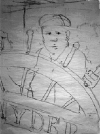
The first drawing of the final composition.
Charcoal on brown paper 30" x 40"
Available for purchase.
Henry's Legacy
Henry can be described as the
consummate son of slaves. The many unspoken rules between blacks and whites
on the river effectively prevented him from becoming a operator in his
own right much less talking to two very young white boys who were to be
his helpers. Where as you can imagine Henry did everything there was too
be done on the river he was given little credit for it. Although I can
remember no times when Henry was looked down on or in any way treated
as a second class citizen I am sure the effects of bigotry and segregation
effected him even in the twilight of his life.
Henry As Tom
Remembers Him
The first sketch
for the portrait
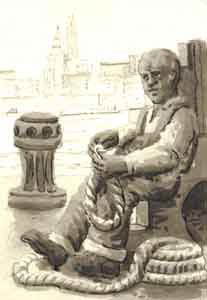
4" x 5",
watercolor on paper
About Tom Lohre
Tom Lohre is a fine artist who
has painted portraits, landscapes and special commissions for over twenty
years as his sole means of income. He obtained a bachelors in communications
from Northern Kentucky University. He trained under master portrait painter
R_, who has painted more living royalty than any other living artist.
R_ taught Tom by having him paint copies in art museums. He showed Tom
that the world of a social portrait painter was a combination of social
grace, flamboyant manners and extravagant spending. They lived in the
fashionable style of the late sixties, high society, well dress, name
dropping with lots of drinking. R_ showed Tom how to seek and produce
society portraits. They were dangerous men living on the edge. Without
the twelve step program they both would have died in the gutter. But fast
living and easy money gave them no true love.
As part of his painting career Tom maintained an apartment in Greenwich
Village NYC for twenty years. He developed his portrait manner and traveled
circuit of Palm Beach, Nantucket & New York City. But on one
of his return home trips Tom met Irene Moore, a Southern transplant working
in the field of geriatrics for the University of Cincinnati. They loved
each other and he married her giving up the circuit for love. It was not
as if he was truly giving up anything. His patrons had always had great
flare, style and intelligence. The qualities he had seen in the ladies
he worked for he saw in Irene. Living with her in Clifton was more the
provincial life he had come to know while traveling about living on estates
and painting along the Eastern Seaboard. But provincial life had Tom drawing
inwards. In four years of returning home he learned classical pastel and
watercolor manners. In six years he accomplished the great landscape manner.
He has produced over 1,400 paintings and 80% are in collections worldwide.
He now seeks to produce art in a contemporary manner. He eventually plans
a robot that would engage you in a conversation while it painted you.
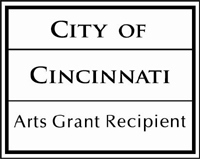
|